Beretta Unleashes the New DT11 on America

Locked in international tournament combat with Krieghoff and Perazzi, the Beretta DT10 has taken more medals in competitions than any other shotgun. In fact, since 1956 Beretta shotguns have dominated the Olympics.
Now with three brand new DT11 over/unders, Beretta is intent on maintaining its monopoly on the winner’s circle for sporting clays, FITASC, skeet and trap as the DT10 enters retirement.
The DT11 marks a corporate inflection point for Beretta USA. The DT11 arrives at a time of new leadership and marketing initiatives that take the company further down the lifestyle path as most evident by the wildly popular Beretta shooting apparel and accessories.
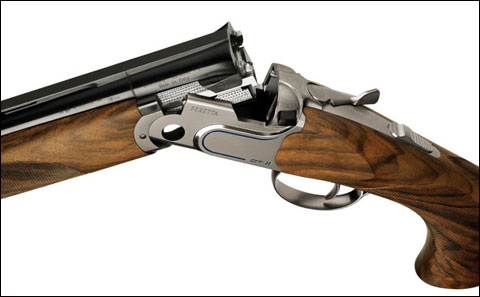 Beretta’s DT11 is constructed to withstand the rigors of international clays competition.
Beretta’s DT11 is constructed to withstand the rigors of international clays competition.Notably, we can expect to see more synergy between Beretta and the Sporting Heritage Group, which created and manages the Beretta Trident Program – a proprietary system that rates shooting sports venues. Tridents are awarded for excellence, like Michelin stars are for restaurants.
The growing relationship between both organizations was clearly demonstrated at the DT11 launch. Beretta invited the media in mid-July to the Beretta Shooting Grounds at Dover Furnace in Dover Plains, New York. The Berretta Shooting Grounds at Dover Furnace is the first clays venue in the Beretta Trident program. It has been awarded two Tridents out of a possible three.
Due to be formally unveiled later this year, the Beretta Shooting Grounds at Dover Furnace will host the first Beretta Discovery Shooting School. Part of the curriculum, designed by Dan Carlisle, intends to help competitive shooters hone their game under the tutelage of winner-circle regulars such as Will Fennell and Anthony Matarese, Jr. A certification program currently under way teaches recreational instructors the method for everyday clays enthusiasts.
 Welcome to the Beretta Shooting Grounds at Dover Furnace.
Welcome to the Beretta Shooting Grounds at Dover Furnace.“If you’re a real serious competitive shooter and want to take your game to the next level, this is one of those exclusive schools,” said Ryan Muety, Director of Marketing & Consumer Direct at Beretta USA. At the same time, Beretta is embarking on significant initiatives to embrace new shooters such as youth and women into the shotgun sports, he explained, and the Beretta Shooting Grounds at Dover Furnace is pivotal in those programs.
“The shooting grounds is intended to be a home base, if you will, for all things Beretta that are shotgun shooting sports related,” said Jonathan Sherrill, Principal of the Sporting Heritage Group.
Mr. Sherrill elaborated that the Beretta Shooting Grounds at Dover Furnace will eventually host game-fair like events that give both new and experienced shooters an opportunity to indulge in the Beretta lifestyle. For example, the Beretta Discovery School will subsequently conduct classes for waterfowl and upland hunting.
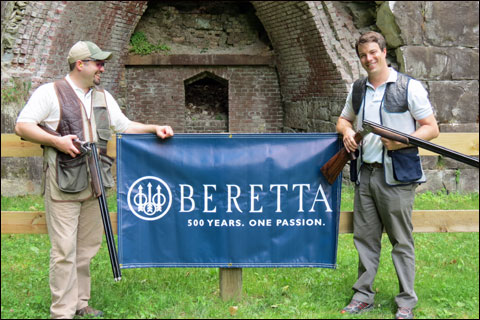 Holding the new DT11 Sporting, Jonathan Sherrill (left) and Ryan Meuty stand in front of the remnants of the Sharpton Hot Blast Charcoal Furnace on the Beretta Shooting Grounds at Dover Furnace. The furnace was built in 1881.
Holding the new DT11 Sporting, Jonathan Sherrill (left) and Ryan Meuty stand in front of the remnants of the Sharpton Hot Blast Charcoal Furnace on the Beretta Shooting Grounds at Dover Furnace. The furnace was built in 1881.Expect the DT11 to figure prominently in the Beretta Discovery School. One of the umbrella courses of the Beretta Discovery School will the Victory School, named after the market segment of Beretta’s clays shotguns. It will be home to the likes of Mr. Carlisle, Mr. Fennell and their colleagues.
As it turns out, the Beretta Shooting Grounds at Dover Furnace will also serve clients of the Beretta Gallery in New York. Dover Plains is about 80 miles north of Manhattan. Within 90 minutes, sales personnel and customers can be there evaluating shotguns – as was evident with the DT11 rollout.
The presence of Mr. Fennell and Mr. Carlisle highlighted the competition pedigree of the DT11.
Mr. Carlisle has more than 15 years of coaching Olympic, world and national champions. He’s an Olympic Medalist, winner of 13 National Main Event Championships and a four-time Hall of Fame inductee. He’s now Chief Instructor at the Gold Medal Shooting Academy, which teaches the Carlisle Triangle Method.
Mr. Fennell is an international FITASC champion, Zone 4 Sporting Clays Champion, nine-time member of Team USA and Chevy Sportsman’s Team Challenge Champion. An instructor, he also teaches the Carlisle Triangle Method.
The DT10 was their go-to gun. Today, it’s the DT11.
 Will Fennell (foreground) and Dan Carlisle (blue shirt) were on hand to help writers improve their clays game at the DT11 launch event.
Will Fennell (foreground) and Dan Carlisle (blue shirt) were on hand to help writers improve their clays game at the DT11 launch event.
The DT11 is heir to the DT10’s competition legacy. These guns are not high-volume, big-box-retail moneymakers. Like the DT10, which was unleashed on the world in 2000, the DT11 is assembled by the Premium Gun Group in Brescia, Italy where the same artisans who hand finish the magnificent SO family of sidelocks, the stunning Giubileo, the achingly beautiful EELL series as well as Beretta bespoke masterpieces, apply their expertise to purposeful competition models.
With Dr. Niccolò d’Amico heading up design and overall product development, the DT11 emerges from the Premium Gun Group with metallurgical and manufacturing breakthroughs in barrel fabrication engineered to minimize recoil, muzzle jump and pellet deformities. Otherwise, the DT11 incorporates a wish list of incremental improvements to the DT10.
Overall, the DT11 capitalizes on the DT10’s unshakable reputation for durability and reliability to withstand hundreds of thousands of rounds under grueling conditions. The cross-bolt locking system, thick barrels, bank-vault receiver, palm swell and Micro-Core recoil pad compound the indestructibility and comfort requirements for marathon international tournaments.
For the official American launch of the DT11, Beretta invited the media in mid-July to the Beretta Shooting Grounds at Dover Furnace in Dover Plains, New York. Europe and Australia, meanwhile, got a jump on the DT11 by a few months.
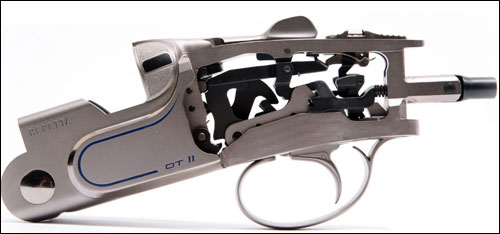 The drop-out DT11 trigger group.
The drop-out DT11 trigger group.At the Beretta Shooting Ground at Dover Furnace, Beretta circulated plenty of sporting, skeet and trap DT11 models that were personally evaluated over the different disciplines. Fiocchi supplied the shells, but more importantly Beretta provided expertise by having on hand Team Beretta champions, Mr. Carlisle and Mr. Fennell who sidled up next to us with invaluable tips.
For starters, the DT prefix stands for detachable trigger. In the heat of competition, anything can happen and so a third position on the safety switch, in conjunction with opening the gun, lets the mechanical, selective trigger group drop out for quick repairs, instant swap-out and ongoing maintenance. The trigger group of the DT11, the same as the DT10, felt like it had a pull of 3½ pounds. It was silky smooth and predictable – the contour of the adjustable trigger shoe easy on the finger.
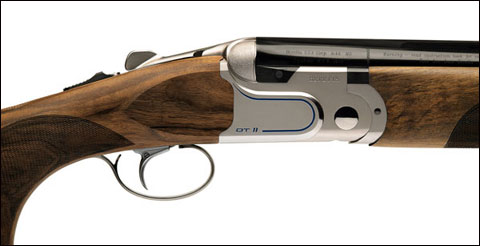 You can see the improved ergonomics of the safety switch and top lever of the DT11.
You can see the improved ergonomics of the safety switch and top lever of the DT11.Ergonomic tweaks to the DT11 included a new high-tactile switch for safety and barrel selection, non-slip hand checkering plus a thumb-friendly top lever to ensure decisive breach opens.
When it came to the receiver, Beretta’s ergonomics turned more serious. Beretta widened it by 3mm, resulting in thicker walls. The desired effect is twofold: better command of the gun, but foremost the extra weight was applied around the hinge-pin balance point to deliver a centered integrity between the hands for superior handling.
Some people, though, wondered if the 12-gauge DT11 Sporting could stand a diet. At nearly nine pounds with 32-inch barrels, standard comb and flat rib, the DT11 Sporting ranged from one-half to three-quarters of a pound heavier than the DT10 Sporting. Depending on equipment, the DT11 Sporting could weigh about four ounces more than a Perazzi MX-9. Still, the DT11 Sporting would be closer in heft to Krieghoff’s K-80 Sporting. Ultimately, weight can be mitigated by shooting dynamics as Krieghoff has successfully established through its own extensive collection of trophies.
With that in mind, each DT11 is individually balanced. The craftsmen of the Premium Gun Group gradually add lead ballast in the stock until the gun is perfectly balanced at the hinge pins. That means, like Krieghoff, you won’t find supplemental weight balancing kits for barrels and stocks any time soon from Beretta for the DT11.
 Dr. Niccolò d’Amico.
Dr. Niccolò d’Amico.As Dr. d’Amico explained: “Each gun passes through a balance check and each gun is hand balanced taking into consideration barrel length, barrel weight and wood density. If the market will demand an after-market weight system we’ll evaluate the opportunity in the future.”
The receiver of the DT11 exhibited an aesthetic that successfully thrust the gun forward into the next decade while respectful of traditional boxlock lines. Dr. d’Amico’s team applied a jeweled, satin, nickel finish contrasted with matte indentations underneath shaped like a pair of Japanese Tanto blades and up top beautifully sculpted matte fences stippled by hand. There’s a color I call “Beretta Blue” that you see on the company’s guns (like the scallop on the 391 Target Gold semi-auto) and select accessories, which is discretely applied to the DT11 receiver via a pinstripe border and the DT11 logo. Coupled with high-grade, oil or wax-finished Turkish walnut, the gun presents itself as a powerful instrument of clays devastation, although the design vernacular seemed more Teutonic than Italian. Regardless, you need to see the DT11 with your own eyes in order to fully recognize the authoritative quality it exudes.
The most significant enhancement to the DT11, however, can only be appreciated when the gun is shot: meet the new Steelium Pro barrels.
Steelium has been used in Beretta’s shotgun barrels since 2009. Steelium barrels result from a unique process of a patented tri-alloy steel created for optimal ballistics. Steelium barrels are deep drilled, cold hammer forged and undergo a special vacuum distension that restores the alloy’s original characteristics after the correct bore diameter is achieved during manufacturing.
Beretta’s Steelium barrels appeared on the DT10. Steelium was also used on the barrels for the 686 Evo and A400 semi-autos. But with the DT11, Beretta introduced the next generation of Steelium called Steelium Pro.
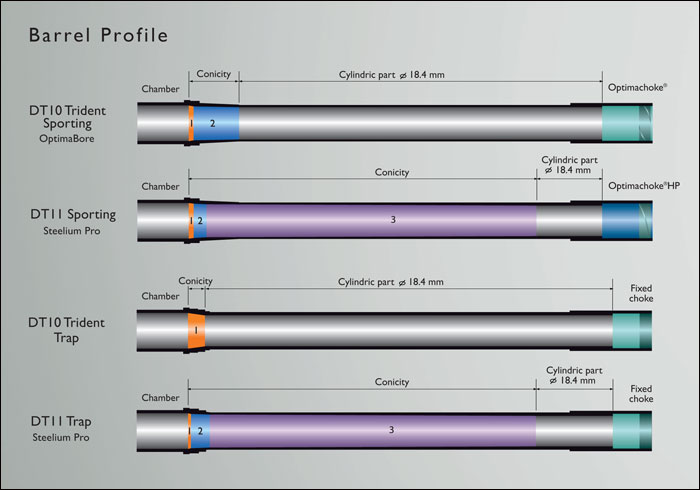 With purple representing the forcing cones, you can see the dramatic difference between the DT10 and DT11 Sporting and Trap models.
With purple representing the forcing cones, you can see the dramatic difference between the DT10 and DT11 Sporting and Trap models. Beretta refined the Steelium process to elongate the forcing cones. Now there’s no sudden forcing-cone constriction at the breech as the shot pellets discharge into the barrel. Steelium Pro has basically turned the bore into a continuous forcing cone that gently flows to the muzzle. The DT11’s bore size is 0.767 in front of the forcing cones and then gradually tapers to 0.725 behind the chokes. Steelium Pro complements the long, slender Optimachoke HP screw-in chokes. Together, the system curtails felt recoil, muzzle jump and shot deformation, according to Beretta.
FITASC champ Mr. Fennell elaborated on the improved patterning of the DT11 Sporting’s Steelium Pro barrels on the 50-plus yard shots that are de rigueur for the sport. “You can draw smoke off targets at 50 yards,” he said.
Without actually patterning the DT11 Sporting, I can only testify to near-zero felt recoil shooting a variety of Fiocchis from the Little Rhino (1 oz., #8, 1250 FPS) to the mighty White Rhino (1⅛ oz., #8, 1250 FPS). During 200 rounds of sporting clays throughout one day, the DT11 Sporting proved smooth and composed on single shots, reports and true pairs. If the gun faltered, it was driver error.
So how did the DT11 shoot?
First, all three models fit quite well for someone like me of average build.
Still, the DT11 Sporting presented itself as extremely poised and neutral with a smooth inertia trigger. Unlike some shotguns in its weight class, the DT11 Sporting required minimum effort to start swinging while at the same time delivering the momentum and follow through that you’d expect. Again, it all comes back to picture-perfect balance and the positive attributes of aerospace tolerances.
The DT11 Skeet model was one of those guns that would be easy to take for granted. The gun did its job well, quietly and uneventfully.
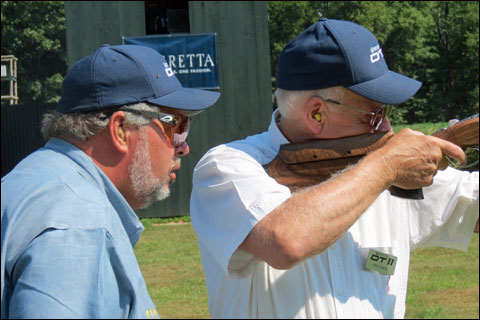 Will Fennel coaches writer Nick Sisley who is shooting a DT 11 Trap gun.
Will Fennel coaches writer Nick Sisley who is shooting a DT 11 Trap gun.Ultimately, the DT11 Trap won my heart as the favorite of the new trio. I took a few shots to dial in the gun without really adjusting the comb, high rib or trigger. Basically, someone handed me the over/under trap gun and I started shooting it. Soon, I was completely crushing birds at 16 and 27 yards. The point of impact was consistent and the entire gun moved to the breakpoint with no fuss. That gun spoke to me.
For now, the DT11 Sporting lacks the adjustable comb of its trap and skeet siblings. Dr. d’Amico alluded to a B-Fast version coming next year that will feature the same innovative B-Fast system as the skeet and trap models. The B-Fast technology naturally provides height modification. It’s distinguished by lateral adjustment (cast) of three degrees. For Beretta owners disappointed with the durability of plastic pieces on the adjustable comb Memory System, you’ll be pleased to know that the B-Fast technology is made entirely of a light-weight alloy. Say goodbye to Super Glue.
At the same time, 2013 may see a high-rib DT11 Sporting. In talking with Mr. Muety, he explained that the high-rib sporters are a distinct American phenomena. Olympic shooters don’t use them – serving as a benchmark for product roadmaps given the Beretta family’s passion for international competition.
It’s possible, though, that a variation of the rib on the DT11 Trap gun could appear on the DT11 Sporting in recognition of the American clays shooter. It’s adjustable both fore and aft for a level sight plane.
If we do see a high-rib DT11 Sporting, Mr. Muety expects the gun to be marketed as an all-around clays gun for trap, skeet and sporting clays.
In terms of price, the DT11 Sporting with either 30-inch or 32-inch barrels starts at $8,000. The skeet gun starts at $8,500 with 28-inch barrels. The trap model starts at $9,200, and is available with 30-inch and 32-inch barrels.
By the way, Beretta’s Matteo Recanatini sat down with Will Fennel during the event to talk about the DT11. You can watch that video here.
Irwin Greenstein is the Publisher of Shotgun Life. You can reach him at letters@shotgunlife.com.
Useful resources:
The Beretta DT11 web page
The Beretta Shooting Grounds at Dover Furnace web site
The Beretta Trident Program web site
The New Beretta Gallery web site
The Gold Medal Shooting Academy web site (Dan Carlisle)
Will Fennell’s web site
The Sporting Heritage Group web site

Irwin Greenstein is Publisher of Shotgun Life. Please send your comments to letters@shotgunlife.com.


Comments